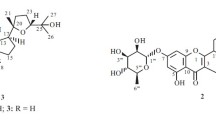The extraction and isolation of biomolecules were carried out from the active fractions of Muntingia calabura which exhibited stronger antibacterial activity. Among all the extracts, methanol and ethyl acetate extracts of M. calabura stem bark showed strong antimicrobial activity. Bioassay guided fractionation of methanol and ethyl acetate extracts acquired from the hardwood stem of M. calabura was done using silica gel column chromatography (100 – 200 mesh) to identify the active fractions and to eliminate the non-active fractions. Hexane and ethyl acetate were used as eluent in different ratios. 5,8-Dihydroxy-6,7,4′-trimethoxy flavones, 6,4′-dihydroxy-3′-propen chalcone, 7-(alloxy)-2-phenyl-4H-chromen-4-one, 7-hydroxy-4-oxo-2-phenyl-4Hchromen-8-carbaldehyde were isolated and identified as flavonols. The structures were established from IR, 1H NMR, 13C NMR, and mass spectral data.





Similar content being viewed by others
References
Z. A. Zakaria, T. Balan, A. K. Azemi, et al., BMC Complement. Altern. Med., 16, 78 – 94 (2016); https://doi.org/10.1186/s12906-016-1041-0.
T. Balan, M. H. M. Sani, V. Suppaiah, et al., Pharm. Biol., 52, 410 – 418 (2014); https://doi.org/10.3109/13880209.2013.839713.
Z. A. Zakaria, N. A. Mohd. Nor Hazalin, S. N. H. Mohd. M. Zaid, et al., J. Nat. Med., 61, 443–448 (2007).
M. Sridhar, K. Thirupathi, G. Chaitanya, et al., Pharmacologyonline, 2, 626 – 632 (2011).
Y. I. Kandil, A. D. Maraqa, G. A. Oriquat, and Z. A. Shraidehm, Bull. Fac. Pharm. Cairo. Univ., 55, 319 – 323 (2017).
N. D. Mahmood, N. L. M. Nasir, M. S. Rofiee, et al., Pharm. Biol., 52, 1598 – 1623 (2014); https://doi.org/10.3109/13880209.2014.908397.
A. S. Sufian, K. Ramasamy, N. Ahmat, et al., J. Ethnopharmacol., 146, 198 – 204 (2013); https://doi.org/10.1016/j.jep.2012.12.032.
A. B. Yildirim, F. P. Karakas, and A. U. Turker, Asian Pac. J. Trop. Med., 6, 616 – 624 (2013); https://doi.org/10.1016/S1995-7645(13)60106-6.
C. Cavaliere, A. L. Capriotti, G. La Barbera, et al., Molecules, 23(12), 3091 (2018); https://doi.org/10.3390/molecules23123091
T. Balan, M. H. M. Sani, S. Mumtaz Ahmad, V. Suppaiah, et al., J. Ethnopharmacol., 164, 1 – 15 (2015); https://doi.org/10.1016/j.jep.2014.12.017.
S. N. Bezenjani, I. Pouraboli, R. M. Afshar, and G. Mohammadi, Iran J. Pharm. Res., 11, 1235 – 1241 (2012).
Z. A. Zakaria, T. Balan, V. Suppaiah, et al., J. Ethnopharmacol., 151, 1184 – 1193 (2014); https://doi.org/10.1016/j.jep.2013.12.045
S. Z. Halim, Z. A. Zakaria, M. H. Omar, et al., BMC Complement. Altern. Med., 17(1), 488 (2017); https://doi.org/10.1186/s12906-017-1992-9.
L. J Zhang, J. P Yu, D. Li, et al., World J. Gastroenterol., 10(1), 77 – 81 (2004); https://doi.org/10.3748/wjg.v10.i1.77.
W. Zhang, X. Zhang, K. Zou, et al., Food Funct., 8, 3130 – 3138 (2017); https://doi.org/10.1039/C7FO00399D.
K. T. Chung, W. R Thomasson, C. D. Wu-Yuan, J. Appl. Bacteriiol., 69, 498 – 503 (1990); https://doi.org/10.1111/j.1365-2672.1990.tb01541.x.
Y. M. Kim, Y. K. Jeong, M. H. Wang, et al., Nutr., 21, 756 – 761 (2005); https://doi.org/10.1016/j.nut.2004.10.014.
S. Chandra, P. Chatterjee, P. Dey, S. Bhattacharya, Asian Pac. J. Trop. Biomed., 2, 178 – 180 (2012); https://doi.org/10.1016/S2221-1691%2812%2960154-3.
C. A. Winter, E. A. Risley, G. W. Nuss, Exp. Biol. & Med., 111, 544 (1962).
A. Matkowski, M. Piotrowska, Fitoterapia, 77(5), 346 – 353 (2006); https://doi.org/10.1016/J.FITOTE.2006.04.004.
S. M. Klein, G. Cohen, A. L. Cederbaumm, Biochem., 20, 6006 – 6012 (1981); https://doi.org/10.1021/bi00524a013.
R. Govindarajan, S. Rastogi, M. Vijaykumar, Biol. Pharm. Bull., 26, 1424 – 1427 (2003); https://doi.org/10.1248/bpb.26.1424.
M. Nishikimi, N. A. Rao, K. Yagi, Biochem. Biophys. Res. Commun., 46, 849 – 854 (1972); https://doi.org/10.1016/s0006-291x(72)80218-3.
G. Ilhami, A. A. Haci, C. Mehmet, Chem. Pharm. Bull., 53, 281 – 285 (2005).
Author information
Authors and Affiliations
Corresponding author
Rights and permissions
Springer Nature or its licensor (e.g. a society or other partner) holds exclusive rights to this article under a publishing agreement with the author(s) or other rightsholder(s); author self-archiving of the accepted manuscript version of this article is solely governed by the terms of such publishing agreement and applicable law.
About this article
Cite this article
Marupati, S., Kethireddy, S. & Eppakayala, L. Isolation, Characterization of Bioactive Compounds from Muntingia calabura – a Pharmacological Study. Pharm Chem J 57, 1941–1949 (2024). https://doi.org/10.1007/s11094-024-03100-6
Received:
Published:
Issue Date:
DOI: https://doi.org/10.1007/s11094-024-03100-6




